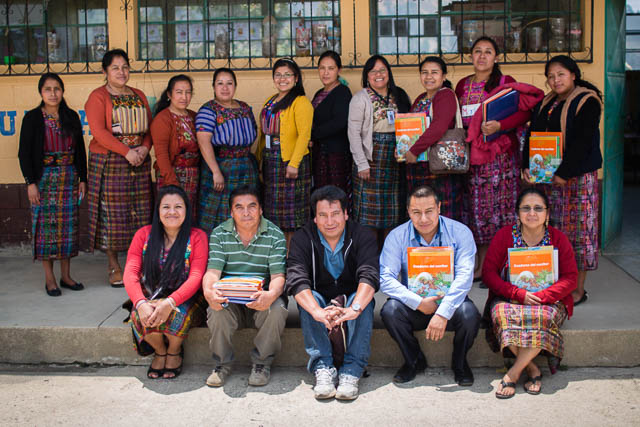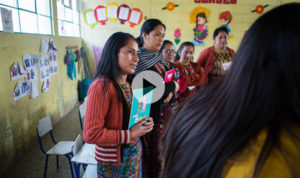
Three of Child Aid’s newest Reading for Life schools are also some of the most remote. The tiny communities of Xeatan Alto, Chuinimachicaj, and Chichoy Bajo are located in the mountains high above Lake Atitlan in the state of Chimaltenango. Because of the altitude, it is cold and foggy much of the year, and the crops in this agricultural area are typically corn and beans as well as onions, carrots, and broccoli. This is one of Guatemala’s poorest regions and families must scrape by on a few dollars a day — barely enough for food and the basic necessities of life.
“Working in the smaller rural schools is a priority for us because those students and teachers face the biggest challenges. Not only are they in some of the poorest and most disadvantaged communities, they typically get the least amount of support,” says Child Aid Country Director Angus Fredenburg.
Life in these communities can often seem shut off from the outside world. The community of Xeatan Alto, for example, is a 45 minute bus trip down to the nearest town of Patzun. Most people speak only the local indigenous language of Kaqchikel and rarely travel outside their local area.

This sense of isolation is even more acute for the teachers working in these communities.
Not only do they have very little training and few resources to work with, they rarely have opportunities to meet and exchange ideas with other teachers outside of their own school.
“Because of their location, teachers in rural schools get very little supervision or support from school district officials,” says Fredenburg. “They are often forced to figure things out on their own, which can be really frustrating and dispiriting. So the opportunity to gather for a workshop and interact with teachers from other schools can be an exciting experience if it’s done right.”
A few weeks ago, nine teachers from the three schools gathered for their very first Child Aid workshop, which most of the teachers said was different than what they expected going in.
“The [Ministry of Education’s] teacher workshops are all the same,” says second grade teacher Linsa Yos Cocon. “We receive information in a lecture and we talk about the same things, but we don’t have any way to use them so nothing changes.”
Child Aid workshops give participants a very different training experience, getting them out of their chairs and actively involved in the learning process.
In this first Reading for Life workshop, Literacy Trainer Heidy Coyote focused on the theme of “Reading for Comprehension.” Teachers learned a variety of tools they can use to develop students’ basic literacy skills including read-alouds, interactive reading and how to discuss the characteristics of good readers with their students. The workshop also introduced teachers to Child Aid’s educational philosophy, which emphasizes collaborative learning and the importance of students becoming independent learners and critical thinkers.
Teachers practiced doing read alouds in front of the group, trying out new techniques for engaging students while developing their comprehension skills. They participated in discussions about reading strategies and worked together in small groups to develop their first read aloud lesson plans.
“When teachers come to their first workshop, we see that at the beginning many are reluctant to participate because they are not sure what to expect,” says Lead Child Aid Trainer Graciela Pichiya. “In the formal [Ministry of Education] trainings, they give teachers the theory but don’t teach them how to teach. When we show them strategies and techniques like “read aloud” or “guided reading” to support the children and help them learn, it changes their attitude toward the training. So by the second or third workshop they are very enthusiastic and participating a lot.”
“[The workshop] had more activity and more fun than I expected,” says teacher Carlos Xinico Tum. “I was surprised by that. We broke into groups and did different activities to use the techniques ourselves. This is not like any workshop we normally attend.”
Kindergarten teacher Marta Patal Batz was particularly interested in the read aloud techniques and strategies presented in workshop, and said she was already thinking about how she could use them with her students.
“I do read alouds in my classroom, but I never used them for anything more than reading,” she says. “With the techniques that this workshop taught us, I can start using read alouds as a way to teach content and reading comprehension. That will be very helpful to me.”
The next step for these teachers is a one-on-one coaching session with a literacy trainer. The trainer will visit their classroom and demonstrate the activities they’ve learned with their own students. “Teachers say that the follow-ups are what make the program special,” says Literacy Trainer Marilena Ixen. “They often don’t fully understand what they’ve learned in a workshop until they see it modeled in their classrooms.”
For this group of new Reading for Life teachers, the combination of workshops and coaching will continue throughout their Child Aid training, helping them become more skilled and confident teachers.